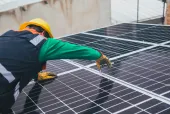Renewable Fit for less than 25 years may turn out to be bad investments
By Agostinho Miguel GarciaEvery government is worried with the current cost of Renewable Energies since they are – in some cases – more expensive than conventional sources, but everyone also knows that electricity cost is increasing every year and the expectations is that it will double in the next decade.
No one is really sure what will happen when the current financial crisis is over.
Let us suppose that electricity prices today are 12 USD cents and we have a Fit of 16 USD cents being paid for 25 and 15 years respectively. What is the expected price after 15 years versus the fixed price of 16 USD cents?
Let us consider several scenarios of increase in prices of 2%, 3%, 4% and 5% each year and the difference between the price of electricity and the Fit as an investment that we can calculate an IRR (Internal Rate of Return).
In the case of the 25 years the IRR are 6%, 13% and 18% for 3%, 4% and 5% respectively while for 2% the balance is negative. For the 15 years case only for 5% increase do we have a positive IRR of 9%.


Conclusion is that it may be better to perform an analysis on the evolution of prices and maximize the Fit paid as an investment and opt for the highest IRR and keep the electricity bounded by a price than to let the market take reins.
There is no guarantee that the IPP (Independent Power Producers) will sell for a lower price than the market price and so Renewable Energies instead of being cheaper will actually benefit from high prices.
India for example can benefit from prices close to the current grid parity for 25 years and so its people may benefit from the low costs of solar and independence in terms of conventional fuels in comparison with 15 years of support that may seem better, but are not. India is paving a new way and Governments should learn.
Fits have to be seen as investments in limiting the future prices of electricity as well as provide extra power independently of the prices of conventional fuels. Where this does not happen the Fit is not correct and needs to be reviewed.














 Advertise
Advertise











